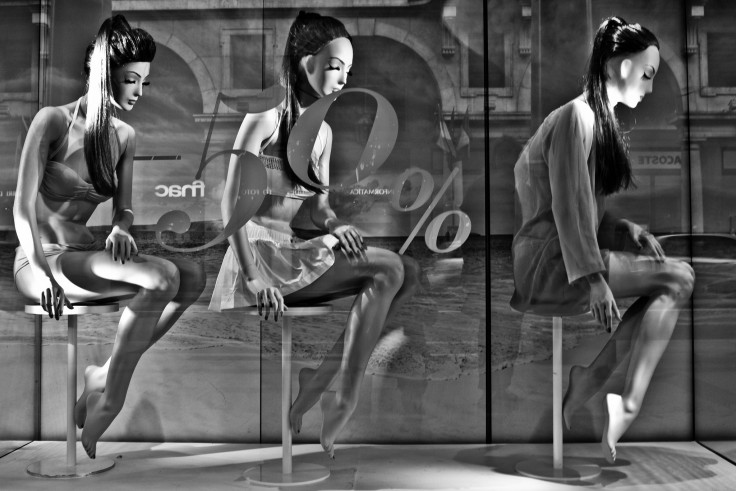Men Perceive Thin Female Body Shape As Physically Attractive Due To Youth And Fertility, According To This Study

America has become obsessed with women like Christina Hendricks, Beyoncé, and Kim Kardashian for their voluptuous body types à la Marilyn Monroe. Although these women have been glorified for their curves by men, science suggests men are initially drawn to women who look more like Kate Moss did in the 90s. According to a recent study published in the journal PeerJ, men find thinner female body types more physically attractive because they associate it with youth, fertility, and a lower risk of disease.
The “ideal body type” varies among gender and a person’s individual preference. These ideal preferences have evolved to signal health and fertility. Although, this influence could also be cultural, especially when you consider how media representations can impact us more than genes or evolution. A 2012 study published in the journal PLOS ONE found that a man’s ideal woman had an hourglass with a small waist-to-hip ratio and a body mass index (BMI) of 18.82. Meanwhile, women preferred men to have an inverted pyramid shape, with broad shoulders and a small waist, and a BMI of 24.5.
But why do men and women find certain features more attractive than others? Professor John Speakman, who coordinated the recent study, contemplated whether evolution has any influence on what we deem attractive. "What we wanted to investigate was the idea that when we look at someone and think they are physically attractive, are we actually making that assessment based on a hard-wired evolutionary understanding of their potential for future survival and reproductive ability?" asked Speakman in the news release.
To explore this theory, Speakman and his colleagues built a mathematical model that combined relationships between levels of obesity, life expectancy, and fertility. The model predicted people would perceive females with a BMI of between 24 and 24.8 as being the most physically attractive. In the U.S., the BMI average for adult men and women is 26.6 and 26.5, respectively.
The researchers tested their prediction on more than 1,300 people living in 10 different countries. Each participant was shown a deck of 21 cards that displayed females of all different body types; then, they were asked to reorder the cards from least to most attractive.
The findings revealed the thinnest images, which meant a woman had a BMI of 19, were rated as the most attractive. When a woman’s BMI increased, the participant’s attraction toward her decreased. This was in direct contrast to the predictions researchers made with the mathematical model, where men found women to be really physically attractive at a BMI of 24 to 24.8. The inconsistency between the model and the study results suggests men associate age with evolutionary fitness.
This term is used to determine what men find appealing. The fitness component of the term is made up of two things, including survival and the ability to reproduce. So, when age was factored into the model, men saw a BMI between 17 and 20 to be the most attractive. This BMI range is associated with younger women aged 18-20,fertility, and the small risk of future disease. Moreover, the researchers found this to be consistent across European, African, and Asian study subjects.
“Setting this into an evolutionary framework allows us to understand why we perceive thinness in females to be so attractive,” Speakman said. “Importantly, it also suggests that historical exposure to famine has not been an important factor.”
Most people are not appalled by the findings since media, culture, and fashion glorify petite figures, but even so, the study provides evolutionary insight we didn’t quite have before.
However, this study does not account for all men. A 2011 study published in the journal Archives of Sexual Behavior found that a woman with an hourglass-shaped figure is more important to men than her breast size or facial features. Men were more interested in learning about the size of her waist compared to her hips, because subconsciously, they preferred a ratio associated with good health and high fertility.
The takeaway of all these studies? Men love women of all different shapes and sizes. The most recent study merely represents men who like a certain type.
Evolutionary factors or not, beauty is only skin deep, ladies.
Sources: Wang G., Djafarian K, Egedigwe CA et al. The relationship of female physical attractiveness to body fatness. PeerJ. 2015.
Crossley KL, Cornelissen PL, and Tovee MJ. What Is an Attractive Body? Using an Interactive 3D Program to Create the Ideal Body for You and Your Partner. PLOS ONE. 2012.
Dixson BJ, Grimshaw GM, Linklater WL et al. Eye-tracking of men's preferences for waist-to-hip ratio and breast size of women. Archives of Sexual Behavior. 2011.
Published by Medicaldaily.com



























